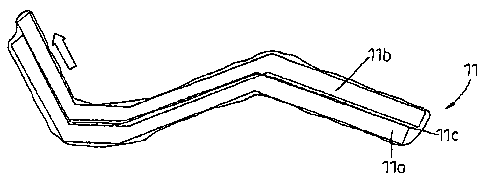Some of the information on this Web page has been provided by external sources. The Government of Canada is not responsible for the accuracy, reliability or currency of the information supplied by external sources. Users wishing to rely upon this information should consult directly with the source of the information. Content provided by external sources is not subject to official languages, privacy and accessibility requirements.
Any discrepancies in the text and image of the Claims and Abstract are due to differing posting times. Text of the Claims and Abstract are posted:
| (12) Patent: | (11) CA 2488147 |
|---|---|
| (54) English Title: | A PRESSURE RELIEVING MATTRESS |
| (54) French Title: | MATELAS REDUCTEUR DE PRESSION |
| Status: | Granted and Issued |
| (51) International Patent Classification (IPC): |
|
|---|---|
| (72) Inventors : |
|
| (73) Owners : |
|
| (71) Applicants : |
|
| (74) Agent: | OSLER, HOSKIN & HARCOURT LLP |
| (74) Associate agent: | |
| (45) Issued: | 2012-02-28 |
| (22) Filed Date: | 2004-11-22 |
| (41) Open to Public Inspection: | 2006-05-22 |
| Examination requested: | 2009-08-13 |
| Availability of licence: | N/A |
| Dedicated to the Public: | N/A |
| (25) Language of filing: | English |
| Patent Cooperation Treaty (PCT): | No |
|---|
| (30) Application Priority Data: | None |
|---|
This invention relates to mattresses, such as pressure mattresses comprising a base portion 11a and an upper portion 11b overlying the base portion and having an interface 11 c between the portions which has a coefficient of friction low enough such that the portions can slide relative to each other. This enables relative movement of the portions, when the mattress is lying on a profiling bed and the bed is being profiled.
Cette invention se rapporte à un matelas, comme un matelas à pression. Ce type de matelas comprend une partie de base (11a) et une partie supérieure (11b) recouvrant la partie de base et comportant un élément de jonction (11c) intercalaire dont le coefficient de frottement est suffisamment faible pour que les parties susmentionnées puissent glisser l'une par rapport à l'autre. Ce processus permet le mouvement relatif des parties, lorsque le matelas repose sur un lit à profilage et que le lit est profilé.
Note: Claims are shown in the official language in which they were submitted.
Note: Descriptions are shown in the official language in which they were submitted.

2024-08-01:As part of the Next Generation Patents (NGP) transition, the Canadian Patents Database (CPD) now contains a more detailed Event History, which replicates the Event Log of our new back-office solution.
Please note that "Inactive:" events refers to events no longer in use in our new back-office solution.
For a clearer understanding of the status of the application/patent presented on this page, the site Disclaimer , as well as the definitions for Patent , Event History , Maintenance Fee and Payment History should be consulted.
| Description | Date |
|---|---|
| Common Representative Appointed | 2019-10-30 |
| Common Representative Appointed | 2019-10-30 |
| Maintenance Request Received | 2014-11-14 |
| Grant by Issuance | 2012-02-28 |
| Inactive: Cover page published | 2012-02-27 |
| Inactive: Final fee received | 2011-12-06 |
| Pre-grant | 2011-12-06 |
| Notice of Allowance is Issued | 2011-11-08 |
| Letter Sent | 2011-11-08 |
| Notice of Allowance is Issued | 2011-11-08 |
| Inactive: Approved for allowance (AFA) | 2011-11-03 |
| Amendment Received - Voluntary Amendment | 2011-10-05 |
| Inactive: S.30(2) Rules - Examiner requisition | 2011-06-06 |
| Letter Sent | 2009-10-13 |
| All Requirements for Examination Determined Compliant | 2009-08-13 |
| Request for Examination Received | 2009-08-13 |
| Request for Examination Requirements Determined Compliant | 2009-08-13 |
| Letter Sent | 2007-10-25 |
| Inactive: Correspondence - Transfer | 2007-07-10 |
| Inactive: Office letter | 2007-06-15 |
| Inactive: Single transfer | 2007-05-03 |
| Application Published (Open to Public Inspection) | 2006-05-22 |
| Inactive: Cover page published | 2006-05-21 |
| Letter Sent | 2005-10-04 |
| Inactive: Single transfer | 2005-09-19 |
| Inactive: First IPC assigned | 2005-02-22 |
| Inactive: IPC assigned | 2005-02-22 |
| Inactive: IPC assigned | 2005-02-18 |
| Inactive: Courtesy letter - Evidence | 2005-01-18 |
| Application Received - Regular National | 2005-01-13 |
| Filing Requirements Determined Compliant | 2005-01-13 |
| Inactive: Filing certificate - No RFE (English) | 2005-01-13 |
There is no abandonment history.
The last payment was received on 2011-11-03
Note : If the full payment has not been received on or before the date indicated, a further fee may be required which may be one of the following
Please refer to the CIPO Patent Fees web page to see all current fee amounts.
Note: Records showing the ownership history in alphabetical order.
| Current Owners on Record |
|---|
| INVACARE UK OPERATIONS LIMITED |
| Past Owners on Record |
|---|
| IAN ROBERT MAHONEY |
| JAN ANTHONY LEWIS |
| LEYTON MARK STEVENS |